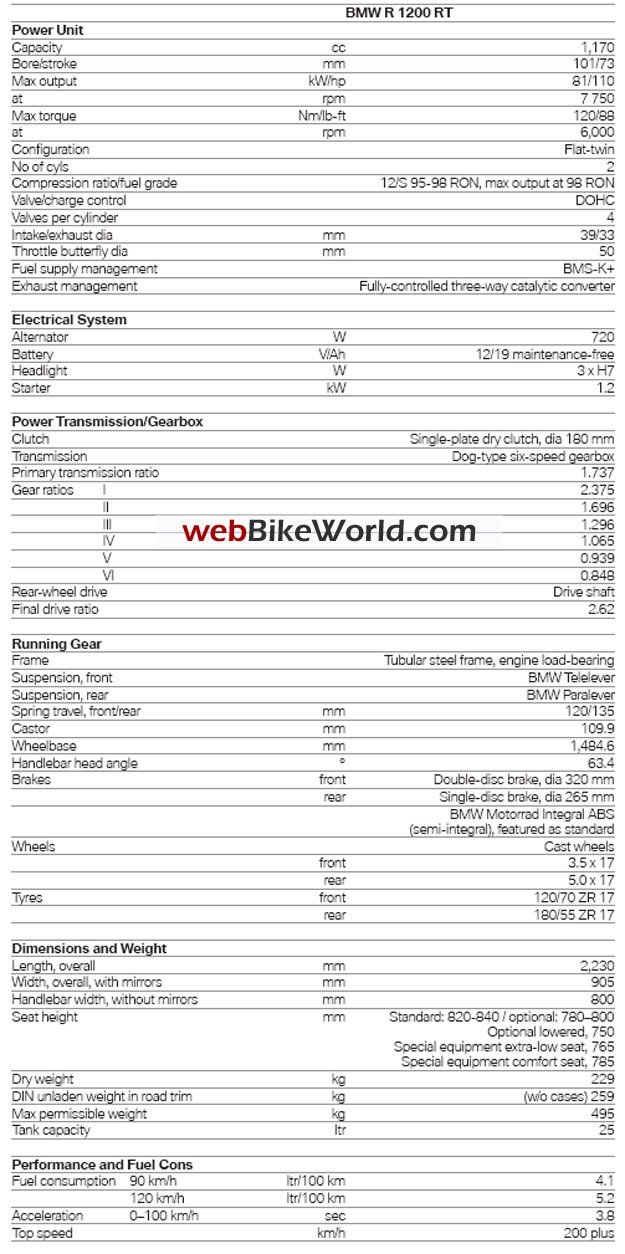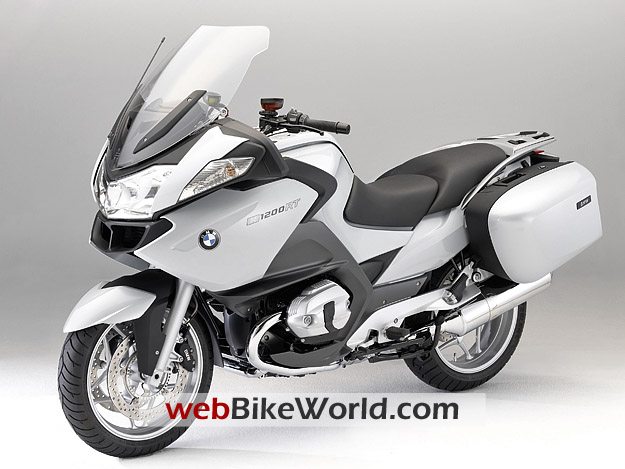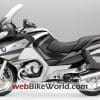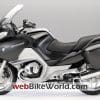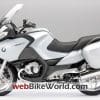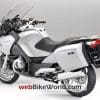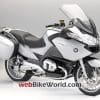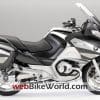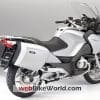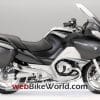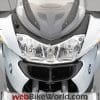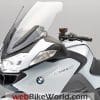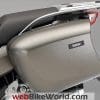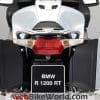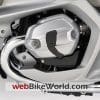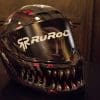2010 BMW R 1200 RT: DOHC = More Power!
The 2010 BMW R 1200 RT: Introduction
November 5, 2009 – BMW today announced the new 2010 R1200RT, along with the 2010 1200GS and R1200GS Adventure (info). The big news is the new dual overhead cam 1200 cc (actually 1170 cc) engine!
The BMW R 1200 RT has always been acknowledged as the epitome of comfortable and dynamic motorcycle touring in classic style. And now, the latest version of this unique active tourer, with its significant innovations, offers even more superior enduro qualities and dynamic benefits thanks to its new boxer engine.
In its configuration and basic structure, the new flat-twin engine is the same as the Double Overhead Camshaft (DOHC) engine featured in the BMW HP2 Sport. It has, however, been further upgraded and optimized for the BMW R 1200 RT to meet the specific requirements of an outstanding tourer.
With the 1170-cc boxer engine on the former model “already offering superior drive power under all conditions and in all situations”, according to BMW, the new R 1200 RT has even more to offer.
BMW says the new engine offers an increase in maximum torque from 85 – 88 lb-ft at an unchanged 6,000 rpm, for even greater acceleration and passing power. Also, the range of useful engine speed has been increased by 500 rpm to a maximum 8,500 rpm.
The third improvement is a significant increase in torque where it really counts at low and medium engine speeds, with a “smooth and homogeneous torque curve”, according to BMW. Maximum engine horsepower is the same as the prior model at 110 hp but occurs now at 7,750 rpm (previously 7,500 rpm).
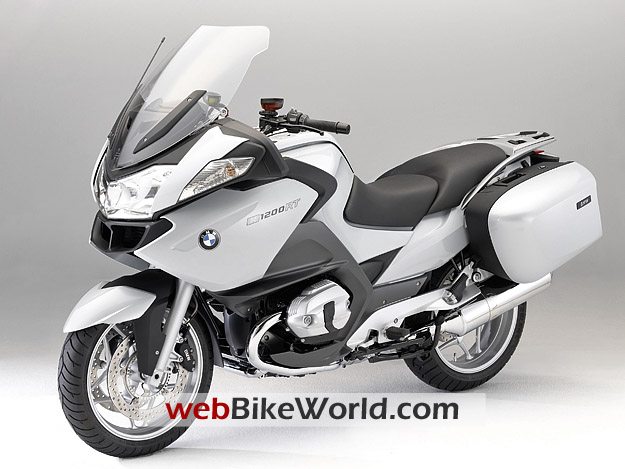
New Boxer Engine for Touring
The BMW R 1200 RT has always been acknowledged as the epitome of comfortable and dynamic motorcycle touring in classic style. And now the latest version of this very special active tourer with its significant innovations offers even more sualities and dynamic benefits thanks to its new engine.
Designed and built for even higher engine speeds, the R 1200 RT’s new boxer engine , like the engine featured on the BMW HP2 Sport, is equipped with two overhead chain-driven camshafts (DOHC) per cylinder.
Valves are operated by very light rocker arms able to cope easily with high engine speeds. Radial arrangement of the four valves allows for a very compact combustion chamber configuration, and like that of the former models, the fuel/air mixture is ignited by two spark plugs (HP2 Sport: one spark plug). The compression ratio of 12.0:1 remains unchanged.
Knock control allows the engine to run on 95-98 RON premium (plus) fuel. Under certain conditions the rider may experience a very small drop in torque and a slight increase in fuel consumption whenever knock control cuts in.
Horizontal arrangement of the camshafts in the direction of travel calls for two special technical features on the new flat-twin engine: Each camshaft controls one intake and one exhaust valve, and the cams are finished in conical shape due to the radial arrangement of the valves.
In the interest of power and performance at low and medium engine speeds, and to provide even better free-revving riding characteristics, the intake and exhaust valve timing on both camshafts has been further improved.
Compared with the former models, the valve bases are up in diameter from 1.41 – 1.54 inches on the intake side and 1.22 – 1.30 inches on the exhaust side. Valve clearance is adjusted by light semi-hemispherical shims. To provide a greater free-valve cross-section, valve lift is up from 0.415 inches on the intake and 0.365 inches on the exhaust side to 0.425 inches on both sides.
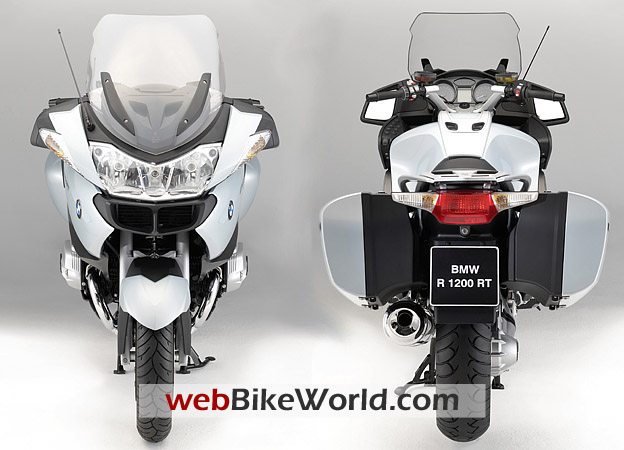
Overview of the main new engine features of the 2010 R 1200 RT
- New, even more dynamic engine with two overhead camshafts per cylinder.
- New DOHC cylinder heads offer an even more efficient cylinder charge.
- Maximum torque increased to 88 lb-ft at 6,000 rpm, maximum output remaining at 110 hp at 7,750 rpm.
- Increase in maximum engine speed from 8,000 to 8,500 rpm, with an even broader power band.
- Significantly improved torque and acceleration.
- Smoother Torque curve.
- Cylinder head covers now with two, instead of four, fastening bolts and a new dynamic design.
- Electronically controlled exhaust flap for superior and powerful sound.
Other new features of the 2010 BMW R 1200 RT include:
- ESA II Electronic Suspension Adjustment with damping, spring base and now also spring rate adjustable at the touch of a button.
- BMW Motorrad Integral ABS featured as standard in the partly integrated version.
- New design fairing with improved protection from wind and weather.
- Re-designed cockpit with visor.
- New control units and hydraulic reservoir.
- Electronically controlled windshield with optimized aero-acoustics and improved transparency .
- • Fairing in new design with protection from wind and weather improved once again.
- Re-designed cockpit with visor.
- New control units and hydraulic reservoir.
- New audio system with controllable interface for a USB/MP3 and iPod, operated through the Multi-Controller.
- Adjustable foot shift lever.
- Hard-shell cases (each with a capacity of 32 liters) featured as standard, with accurately fitting four-point lock system and cover finished in body color.
- Tank railing for conveniently fastening accessories.
- New colors for the R 1200 RT: Polar metallic, Ostra Grey metallic matt, Thunder Grey metallic, multi-color paintwork in conjunction with Thunder Grey metallic base color.
- Extended range of optional extras and special equipment tailored to the R 1200 RT, naturally in top BMW quality.
Significantly More Torque Throughout the Entire Speed Range
The existing ratio of bore to stroke remains the same at 3.98:2.87 inches, giving the engine the same 1,170 cc capacity as before.
Other features borrowed from the former engine are the crankshaft and the connecting rods, as well as their bearings, while the two pistons made of cast aluminum have been re-designed to match the modified dimensions of the combustion chamber.
Interacting with the upgraded intake system, throttle butterfly manifolds now offer 1.97 inches instead of the former 1.85 inches (HP2 Sport: 2.05 inches) opening clearance, newly designed intake air manifolds and an air filter element with increased volume capacity, the engine as in the past develops maximum output of 110 hp, now at 7,750 rpm. The biggest improvement, however, is the increase in maximum torque to 88 lb-ft at 6,000 rpm.
An oil cooler ensures a stable temperature even under extreme riding conditions. A further enhancement on the 2010 model is the use of cylinder head covers with two, instead of formerly four, fastening bolts in a new dynamic design. A valve cover guard made either of aluminum or plastic as well as chrome-plated aluminum cylinder covers are available as accessory items.
Electronically Controlled Exhaust
An electronically controlled exhaust flap is now standard for superior and muscular sound. On the exhaust system the two manifolds come in the same design, length and diameter as on the former model, while the interference pipe has been modified to take the different vibration conditions on the exhaust manifold into account.
Featuring an exhaust flap controlled via an electric motor and opening/closing cables, the new BMW R 1200 RT offers a particularly powerful boxer sound nevertheless in full compliance with all legal standards.
To reduce ram pressure and improve the sound of the engine, the rear silencer unchanged in its exterior design versus the former models comes with a modified interior structure.
Revised Six-Speed Gearbox and Driveshaft
As in the past, power is transmitted through the six-speed gearbox already upgraded in the 2008 model year, with larger bearing diameters and a modified gap between shafts. The maintenance-free drive shaft to the rear wheel is the same as before.
Telelever and Paralever Suspension and Integral ABS
The proven, two-piece main/rear frame sections made of weight-saving steel tubes incorporating the engine as a load- earing element offer maximum strength and stiffness under all running conditions.
The front and rear frame are firmly bolted to the engine/gearbox unit, interacting with the engine and gearbox to form a load-bearing structure. The longitudinal arm on the front Telelever suspension is mounted as before on the engine block, the Paralever swing arm is fitted on the rear frame.
With its fixed tube measuring 35 millimeters/1.38” in diameter, the Telelever is the optimum solution for the rider using the machine exclusively on the road and focusing in particular on superior comfort.
This is ensured by the good balance of sporting and comfort-oriented suspension behavior, the maintenance-free system once again designed to reduce brake dive to almost zero, which again helps to provide greater stability when applying the brakes when leaning over at an angle.
As in the past the Paralever swing arm in the rear central spring strut comes with travel-dependent damping or TDD for short, with the damping effect increasing progressively as a function of spring travel. This keeps the suspension smooth, sensitive and comfortable in absorbing even the smallest bumps, while at the same time offering generous reserves on bad roads and tracks with grooves or big bumps and potholes.
As in the past, spring travel is 120 millimeters/4.72“ up front and 135 millimeters/5.31” at the rear. In standard trim, the rear spring strut offers infinitely variable adjustment on the outbound stroke as well as a hand-wheel for infinitely adjusting the spring base by 10 millimeters or 0.39”, in order to adjust the rear end to varying load requirements.
Like its predecessor, the new R 1200 RT comes on light, almost filigree cast aluminum wheels in five-spoke design, combining an attractive look with an easy-to-clean surface and a high standard of stiffness.
The front wheel measures 3.5 x 17“, the rear wheel 5.5 x 17”, running on a 120/70 ZR17 tire up front and a 180/55 ZR17 tire at the rear.
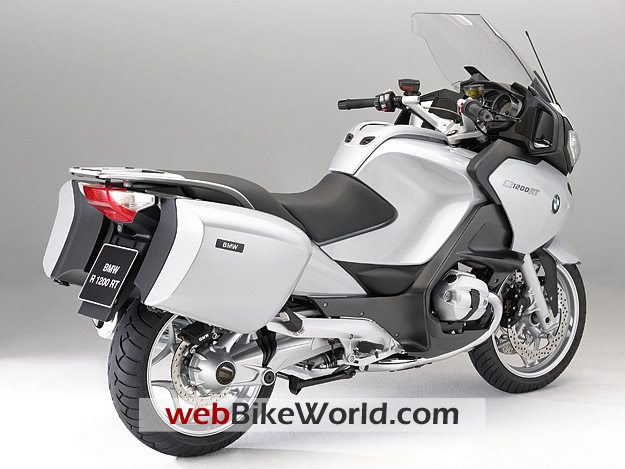
ESA II Electronic Suspension Adjustment
The BMW R 1200 RT is available with ESA II (Electronic Suspension Adjustment II) already well-known from the K series as an option at extra cost.
Benefitting from this system quite unique in the world motorcycle market, the rider is able to adjust not only the damping on the outbound stroke of the front and rear spring strut, but also the spring base (spring pre-tension) on the front spring strut and the spring rate – all this at the simple touch of a button.
This second-generation Electronic Suspension Adjustment or ESA II for short provides the option to set the suspension for maximum comfort and, with greater precision than ever before, for optimum riding and load conditions, thus ensuring a new dimension of riding stability combined with absolutely excellent response.
To control the Electronic Suspension Adjustment as easily as possible and to prevent any unwanted settings, the rider initially enters the motorcycle’s current load condition (solo, solo with luggage, rider with passenger and luggage).
The appropriate spring base and spring rate is then set automatically, with the system coordinating these two parameters to one another.
Depending on the style of riding he wishes to enjoy, the rider must also choose among the Comfort, Normal or Sport mode, giving the suspension the desired qualities. So applying the optimum parameters kept available in the Central Vehicle Electronics, the electronic “brain” calculates the appropriate damper rates and sets them accordingly.
As a result, the new R 1200 RT benefits from a total of no less than nine different set-up options. With additional adjustment of the spring rate, ride height can be set perfectly to various load conditions, ensuring an even higher standard of riding stability, handling and comfort. Even when carrying high loads with a passenger and lots of luggage, the R 1200 RT maintains all of its riding qualities also when leaning over to a low angle in bends, for a truly sporting style of riding at all times.
A further advantage is that adjustment of the spring rate dramatically reduces the risk of the suspension suddenly sagging under extreme load. The rider is able to change the damper setting (Normal, Sport, Comfort) simply by pressing a button also while riding, while for function and safety reasons the spring base may be changed only at a standstill. The spring rate is adjusted by an electric motor complete with its own transmission, while the damping rate is modified by small step motors on the dampers.
Adjustment of the spring rate is controlled by two springs connected in series, one behind the other. An elastomer unit (Cellasto) in combination with a conventional coil spring further down takes up forces under spring pressure, radial expansion of the Cellasto element to the outside being restricted by a steel sleeve.
On the inside the Cellasto element moves an aluminum sleeve by means of electro-hydraulic connection, the position of this inner sleeve influencing the expansion behavior of the Cellasto element to the inside and, therefore, its spring rate.
In all, this interaction of the various units has the same effect as a combination of two springs varying in strength. Whenever the inner sleeve is resting on the steel spring, the Cellasto unit is not in use and only the steel spring provides the desired suspension effect. Once the inner sleeve is moved further, the spring base on the steel spring – and therefore the spring pre-tension – is also varied accordingly.
This configuration significantly improves the normal static position of the motorcycle and riding geometry under all load conditions, without any of the disadvantages encountered with conventional suspension. Benefiting from this self-levelling, the R 1200 RT is just as stable when riding under full load as it is when carrying only the rider without any luggage.
Additional adjustment of the spring rate over the wide range from 160 – 260 N/mm allows far greater variation of the Sport, Normal and Comfort settings on ESA II than on ESA I, with each set-up providing a far greater choice of specific characteristics.
In other words, the R 1200 RT is even more dynamic and precise in the Sport mode, and very comfortable indeed in the Comfort mode, while maintaining an excellent standard of stability.
In all, ESA II offers the following significant benefits:
- Much wider range of settings and suspension options with the Sport/Normal and Comfort modes.
- Far better maintenance of the machine’s static, normal position and riding geometry with all settings.
- Optimum adjustment of the damping and spring rate / spring base in all settings.
- Significant change of the motorcycle’s character through adjustment of the dampers.
- Excellent adjustment to all load conditions through the adjustment of the spring rate / spring base.
- Significant enhancement of safety when braking and in general riding stability, free side angle in bends and firm suspension without sagging.
Partially Integrated ABS Brake System Standard
The proven brake system with BMW Motorrad Integral ABS in its partly integral version featured as standard offers supreme safety at all times. Maximum and controllable stopping power requiring minimum effort on the part of the rider guarantees additional safety particularly when braking in an emergency.
The front brake discs measure 320 millimeters or 12.6“ in diameter, the rear brake disc 265 millimeters/10.4”.
Lighter and More Dynamic Fairing Improves Riding Comfort
The R 1200 RT remains unmistakable in design, simply begging the rider to go out on the road or track at very first sight.
Through its highly attractive black grain surface finish around the air intake at the front of the fairing and around the upper side fairing, to mention just two examples, the R 1200 RT looks even lighter and more dynamic than its predecessor.
More than ever before, the light look of the fairing, which nevertheless offers superior protection from wind and weather, makes the machine a truly unique experience. The intentionally reduced use of color around the mirror
hand guards again contributes to the dynamic appearance of the R 1200 RT, while the integrated direction indicators now with white lenses accentuate the powerful touring character of the machine.
Light edges in the fairing as well as the new cylinder head covers emphasizing the length of the R 1200 RT give BMW’s new motorcycle an even sleeker and more slender look from the side.
The newly designed front wheel mudguard with improved aerodynamics and the optimized engine spoiler also add a
particularly dynamic touch to the design of the new R 1200 RT.
As in the past, the dominating headlight with its sharp contours gives the front end of the R 1200 RT a particularly stylish and truly unique appearance, setting it clearly aside from all other models. Following the free-form surface principle, the headlight unit is made up of two H7 headlights arranged to the right and left for a double low beam and a central light for the high beam, in each case with maximum light intensity.
While so far the headlight was adjusted by means of a lever on the motorcycle at rest, it may now be adjusted most conveniently by a knob on the left side of the cockpit.
The windshield is electrically adjustable to any position desired also on the new R 1200 RT, with variation of windshield height as before by up to 140 millimeters or 5.51”, enough to protect virtually any rider, no matter how tall, even better than before from wind and weather, while reducing the level of noise once again.
To improve aero-acoustics to an even higher level, the windshield has been modified in its design on the upper side section, helping again to significantly reduce wind noise. Windshield transparency has been optimized in this process, with less distortion round the edges as well as less reflection. To reduce vibrations, finally, the windshield support with just one bar has been reinforced and the mirror mounting modified.
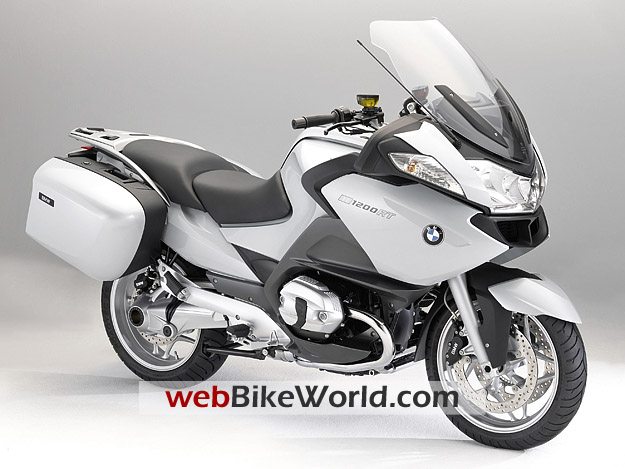
Ergonomics and Features
Re-designed cockpit with additional visor: The cockpit placed as usual perfectly in the rider’s line of vision with its two analogue dials for road and engine speed guarantees perfect presentation and safe supervision of all the machine’s functions. Unlike the former model, the new R 1200 RT comes with a matt visor finished in a dark metallic color above the instruments to avoid any undue reflection.
The instrument cluster itself features a newly designed face, now looking even more modern and sophisticated. The instruments are supplemented by a central screen presenting data such as the coolant (oil) temperature, tank level, the time of day or the gear currently in mesh in the usual proven manner.
On models fitted with ESA II as an option, the instrument cluster also provides information on the current suspension setting.
Data retrievable on demand include the overall mileage, trip mileage and, as soon as tank capacity has dropped to the reserve level, the remaining range on the fuel available.
An on-board computer complete with an oil level warning gauge comes as an option, with the information required (ambient temperature, remaining range, average speed and fuel consumption, tire pressure (special equipment)) also available in the Info Display.
Controls, Hydraulic Reservoir and Handlebar Now Separated to Avoid Vibration
Like the K 1300 models, the new R 1200 RT comes with a brand-new generation of switches and manual controls. The new switches are far smaller and more compact, but at the same time offer a higher level of functional value and come in very clear design.
Apart from the standard direction indicator, horn, high beam and starter functions, the R 1200 RT features controls for the electrically adjustable windshield and the optional handlebar and seat heating, the on-board computer, ESA II, ASC, and cruise control all integrated in the control unit.
As part of this modification, new, square-shaped and separately mounted hydraulic fluid reservoirs in a discreet smoky glass look for the clutch and brake fluid are also fitted in the cockpit area.
To avoid unwanted vibration and offer an even higher standard of riding comfort, the handlebar is now also mounted on rubber bearings to cancel out vibrations. The upper fork bridge now finished in silver complete with the BMW logo underlines the particular style and flair of the R 1200 RT also in this area.
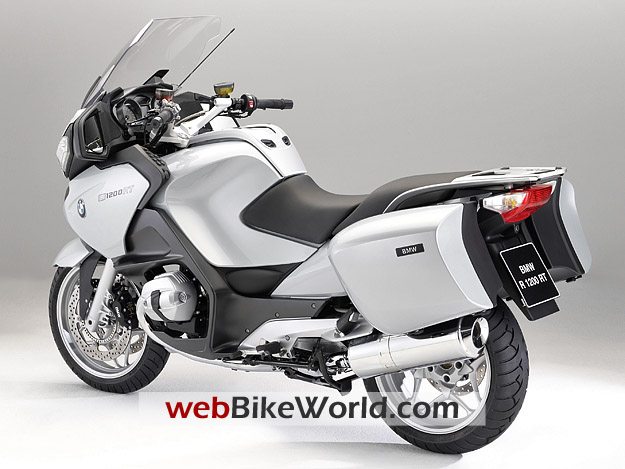
New Audio System and Multi-Controller
An absolute innovation in the motorcycle market is the new Multi-Controller. Fitted on the inside of the left handlebar within optimum reach at all times, the Multi-Controller replaces the former function satellite fi tted further to the inside of the handlebar.
Like a computer mouse, the Multi-Controller responds to turning and pressing of the wheel, enabling the rider to select a specific radio station and music title or vary the volume of the sound system.
The audio system is also brand-new, featuring interfaces for an MP3 player, an iPod or USB stick as well as conventional devices such as a CD player. The CD player fitted on the former model has been dropped.
The new system allows administration of no less than nine playback lists on a USB/MP3 and iPod, with the alternative option to play all titles in random choice. The Info Display presents the volume chosen as well as the title currently being played.
The external devices used may be kept conveniently in a lockable compartment on the right side of the inner fairing, protected safe and sound from wind and weather.
The radio functions themselves are the same as before, but now the new audio system enables the rider to save 24 instead of just six stations. The rider can select stations either manually, through the memory function on stations saved in advance, or through the station search mode looking for the station with best reception (Autostore).
The station currently being played is presented on the Info Display and the speed-related volume control may be set to three different levels.
Over and above the functions provided by the Multi-Controller, the radio control unit is masterminded as before through control knobs on the left side of the inner fairing.
Ergonomics for Long-Distance Riding Comfort Seat
As before, the comfortable seat on the R 1200 RT is split up into two sections, with manual adjustment of the rider’s section to two levels, 820 and 840 millimeters (32.3 and 33.1“).
A lower seat is available as an optional extra, with seat height of 780 and, respectively, 800 millimeters (30.7 and 31.5”). A further option is to lower the entire motorcycle (750 mm/29.5“ seat height including an extra-low seat bench), with a single-piece, extra-low seat bench measuring just 765 millimeters/30.1” in height available as special equipment.
Supreme comfort is ensured by the single-piece comfort seat bench also available as special equipment within the wide range of features coming from BMW Motorrad.
The ergonomic triangle made up of the footrests, seat and handlebar ensures an active seating position with maximum grand touring comfort. The rider and passenger on the R 1200 RT thus enjoy a pleasant knee angle at all times and under all conditions.
Gear Shift
In the process of upgrading the new model, BMW Motorrad has given the R 1200 RT gearshift levers adjustable by an eccentric control bar serving to change the distance between the shift lever and the footrest and once again improve rider ergonomics.
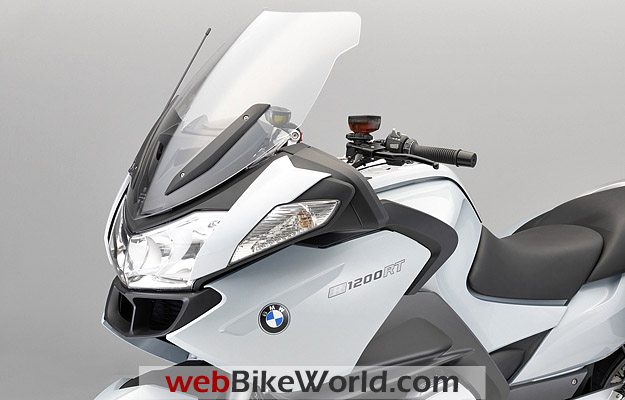


2010 BMW R 1200 RT Options Include
As a systems supplier by tradition, BMW Motorrad has developed a wide range of optional extras and special equipment also for the new R 1200 RT, allowing the discerning customer to personalize the machine to an even higher standard.
Special equipment comes directly from the factory and is fitted during production at the Berlin Plant, optional extras are fitted by the BMW Motorcycle Dealer.
Optional Extras Include.
- ESA II (Electronic Suspension Adjustment II.
- Audio system including Multi-Controller and interfaces for iPod, USB, MP3, etc.
- On-board computer incl oil level warning system.
- Rider’s seat, lower 780 / 800 millimeters (30.7 /31.5”).
- Lowered suspension 750 millimeters (29.5”) including an extra-low seat (available only without seat heating).
- Seat heating (only in conjunction with heated handles).
- Heated handles.
- Second power socket.
- Preparation for audio system.
- Cruise control.
- Anti-theft warning system.
- Exhaust system, chrome-plated.
- Comfort seat, single-piece.
- 79 kW (107 hp) power version or 72 kW (98 PS) power version.
2010 BMW R1200RT Luggage Options
The R 1200 RT comes as standard with hard-shell cases offering a capacity on each side of 32 liters. The case holders are integrated almost fully in the body of the machine, providing a perfect match with the contours of the R 1200 RT.
Case covers finished in high-quality body color and an appropriate surface look matching the overall design of the motorcycle ensure a harmonious overall impression from every angle. A high-class locking system with four locking
points guarantees an exact fit of the case cover as well as reliable seating against water coming in.
The luggage rack offers ample space for additional luggage. As an alternative, the rider may opt for two top cases (either 49 or 28 liters) from the wide range of special equipment. The smaller of these two top cases is finished in black, the larger comes with a cover finished in White Aluminum metallic matt as a contrast to the black grain lower section or, as yet a further option, the cover in Sapphire Black.
A railing is fitted on top of the tank for fastening the tank bag developed especially for this purpose. And last but not least, numerous lashing points for luggage round off the touring package on the R 1200 RT.
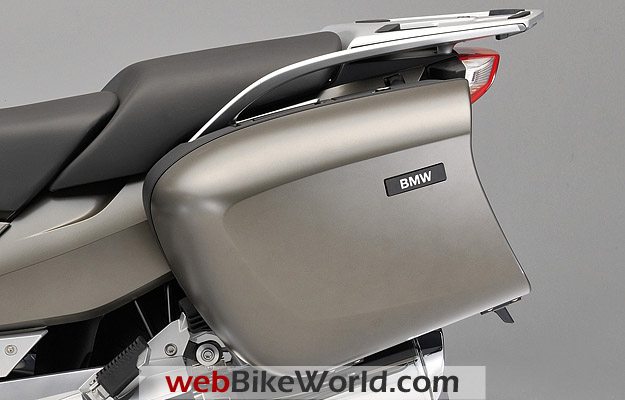


Special Equipment
Bags and Cases
- Top case, large (49 liters), cover in White Aluminums metallic matt or Sapphire Black.
- Top case, small (28 liters).
- Back padding for top case, small.
- Inner bag for top case, large.
- Inner bag for top case, small.
- Inner bag for system case, left or right.
- System case protector, top (transparent fi lm).
- Impact guard for cases.
- Tank bag, watertight, with base plate.
- Vario insert for tank bag.
- Soft bag 2, small, 19 liters.
- Soft bag 2, large, 51 liters.
- Baggage roll, watertight, 53 liters.
- Lashing belt with tightening lock.
- Baggage straps.
- Insert for radio socket.
Ergonomics and Comfort
- Extra-low seat, 765 millimeters/30.1” (single-piece, only without seat heating).
- Rider’s seat, low, 780/800 millimeters (30.7/31.5”), Black or Grey.
- Comfort seat 785 millimeters/30.9” (single-piece, only with seat heating).
- Heated grips.
- Second and third power socket.
Design and Sound
- Cylinder head covers chrome-plated.
- Carbon cover on engine block.
- Akrapović sports muffler.
- Splashguard at the rear.
Safety
- Aluminum cylinder head cover protection.
- Plastic cylinder head cover protection.
- Anti-theft warning system.
- First-aid kit, large/small.
- Safety bolt for oil fi ller manifold.
Navigation and Communication.
- BMW Motorrad Navigator IV with accessories.
- Holder for BMW Motorrad Navigator IV.
- iPod adapter cable (USB/chinch).
- Maintenance and Technical Features.
- Power reduced to 98 hp.
- Paddock stand.
- On-board toolkit/service set.
- LED light for on-board power socket 410 millimeters/16.1”.
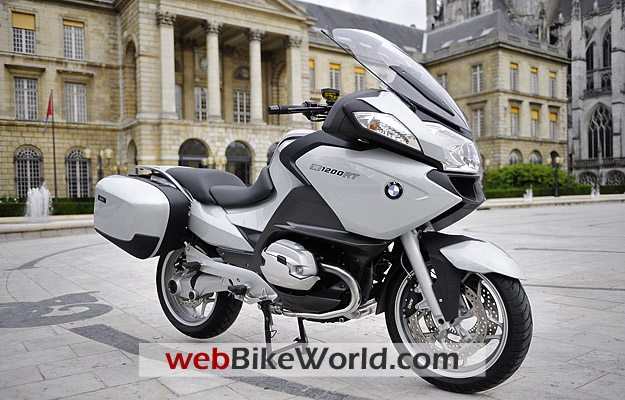


2010 BMW R 1200 RT Colors
The fairing on the new R 1200 RT is lighter and more dynamic than the former fairing with its large surfaces. This lighter and more dynamic look is ensured above all by the sophisticated black-grain surface finish around the side and front sections.
The color concept with four new color shades enhances this effect and gives the R 1200 RT a significantly more compact look through the contrast between the color of the body and the matt-painted engine spoiler as well as the seat finished exclusively in black on all models.
Polar metallic accentuates the dynamic design language of the new R 1200 RT in particularly elegant and sporting style. In conjunction with the engine spoiler finished in Dark Slate metallic matt, Polar metallic is a particularly colorful highlight in the R 1200 RT range.
Thunder Grey metallic in combination with the engine spoiler finished in White Aluminum metallic matt, on the other hand, emphasizes the all-round talent of the new R 120 RT.
Ostra Grey metallic matt sets a powerful contrast to the engine spoiler again finished in White Aluminum metallic matt, providing a very technical look. Twin-tone paintwork based on Thunder Grey metallic, together with sweeping lines in Titanium Silver metallic and Granite Grey metallic, makes the surfaces at the side look even more compact and dynamic.
Together with the exciting breakdown of colors, sets a new and sporting highlight also in conjunction with the cases finished for the first time on a motorcycle in several of the machine’s colors.
See Also:2010 BMW R 1200 GS Info, Photos, Specifications
2010 BMW R 1200 RT Horsepower and Torque Curves
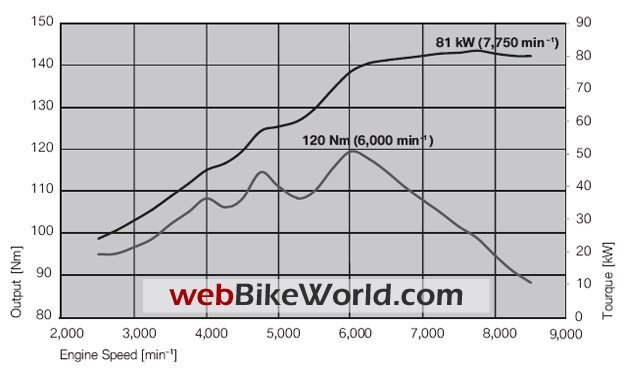


2010 BMW R 1200 RT Specifications
